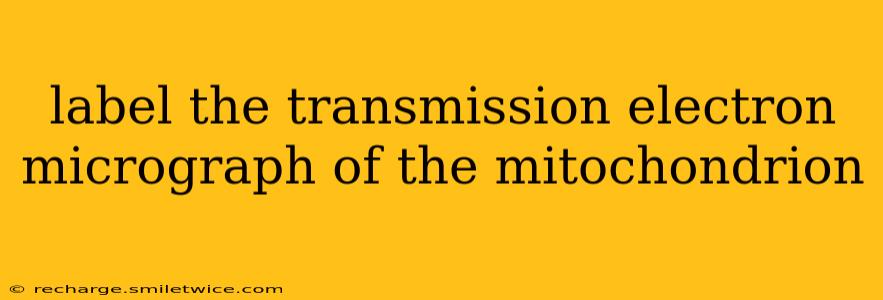Labeling the Transmission Electron Micrograph of a Mitochondrion: A Comprehensive Guide
Mitochondria, often called the "powerhouses" of the cell, are essential organelles responsible for generating the majority of the cell's supply of adenosine triphosphate (ATP), the energy currency of life. Understanding their intricate structure requires a close examination, often facilitated by transmission electron microscopy (TEM). This guide will walk you through labeling the key components visible in a typical TEM image of a mitochondrion.
What is a Transmission Electron Micrograph (TEM)?
A transmission electron micrograph is an image produced using a transmission electron microscope. This powerful tool uses a beam of electrons to illuminate a very thinly sliced sample. Because electrons have a much shorter wavelength than light, TEMs achieve significantly higher resolution than light microscopes, allowing visualization of cellular structures at the nanometer scale. This is crucial for studying intricate organelles like mitochondria.
Key Structures to Label in a Mitochondrion TEM:
Here's a breakdown of the essential components you'll typically find in a TEM image of a mitochondrion, along with their functions:
1. Outer Mitochondrial Membrane
This is the smooth, outermost membrane surrounding the mitochondrion. It's relatively permeable due to the presence of porins, which are large protein channels. It acts as a barrier separating the mitochondrial contents from the cytosol.
2. Inner Mitochondrial Membrane
This membrane is highly folded into structures called cristae. These folds greatly increase the surface area available for the electron transport chain (ETC), a crucial process in ATP production. The inner membrane is impermeable to most ions and small molecules, requiring specific transport proteins for entry and exit.
3. Cristae
As mentioned above, these are the characteristic infoldings of the inner mitochondrial membrane. Their abundance and complexity vary depending on the cell's energy demands. The higher the energy demand, the more cristae are usually present.
4. Mitochondrial Matrix
This is the space enclosed by the inner mitochondrial membrane. It's a gel-like substance containing mitochondrial DNA (mtDNA), ribosomes, enzymes responsible for the citric acid cycle (Krebs cycle), and other metabolic processes.
5. Intermembrane Space
This is the narrow region between the outer and inner mitochondrial membranes. It plays a vital role in the process of oxidative phosphorylation, where a proton gradient is established across the inner membrane to drive ATP synthesis.
Frequently Asked Questions (FAQs):
What is the function of the cristae? The cristae significantly increase the surface area of the inner mitochondrial membrane, providing more space for the proteins of the electron transport chain, thereby maximizing ATP production.
What is found within the mitochondrial matrix? The mitochondrial matrix contains mtDNA (mitochondrial DNA), ribosomes, enzymes for the citric acid cycle (Krebs cycle), and various other enzymes involved in metabolic processes.
How does the inner mitochondrial membrane contribute to ATP synthesis? The inner mitochondrial membrane's impermeability to most ions and molecules, coupled with the proton pumps embedded within it, creates a proton gradient across the membrane. This gradient drives ATP synthase, producing ATP.
Why are mitochondria considered the "powerhouses" of the cell? Mitochondria are the primary site of ATP production through cellular respiration, which converts nutrients into usable energy for the cell. This energy fuels most cellular processes.
How can I tell the difference between the outer and inner mitochondrial membranes in a TEM image? The outer membrane typically appears smoother than the highly folded inner membrane with its characteristic cristae.
By carefully examining a TEM image and understanding the roles of each component, you'll gain a much deeper appreciation for the complexity and crucial function of mitochondria within the cell. Remember to always consult a reliable source for accurate labeling and interpretation of your specific micrograph.
